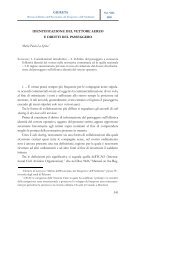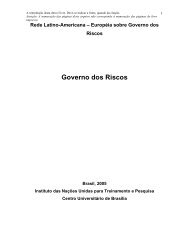Rome II and Tort Conflicts: A Missed Opportunity Abstract Contents
Rome II and Tort Conflicts: A Missed Opportunity Abstract Contents
Rome II and Tort Conflicts: A Missed Opportunity Abstract Contents
Create successful ePaper yourself
Turn your PDF publications into a flip-book with our unique Google optimized e-Paper software.
SYMEON C. SYMEONIDES ROME <strong>II</strong> AND TORT CONFLICTS<br />
an appropriate manner. 128<br />
This recital is what survives from the rapporteur’s <strong>and</strong> Parliament’s efforts to<br />
inject more flexibility into the text of the general rule of <strong>Rome</strong> <strong>II</strong>. As noted earlier, the<br />
Council <strong>and</strong> Commission rebuffed these efforts <strong>and</strong> recital 14 is the resulting<br />
compromise. While much of this recital is self-congratulatory <strong>and</strong> merely describes<br />
the scheme of <strong>Rome</strong> <strong>II</strong>, the italicized phrases can be viewed as providing instruction<br />
to courts on when <strong>and</strong> how to use the escape: to “treat individual cases in an<br />
appropriate manner” <strong>and</strong> to “do justice in individual cases.” Thus, a court should<br />
resort to the escape when the law designated as applicable by the general rule leads<br />
to a result that is incompatible with “the need to do justice in individual cases.”<br />
To be sure, one can object—<strong>and</strong> many will—to such a loose reading of the<br />
escape as giving a licence for loose, ad hoc, subjective judging. While this danger is<br />
real, it is worth the price. The alternative is a quantitative employment of the escape,<br />
which will resolve only the easiest of conflicts. For example, a quantitative<br />
employment of the escape will not resolve the aforementioned Kenyan hunting<br />
accident case involving a French <strong>and</strong> a Belgian hunter, whereas an employment of the<br />
escape with a view toward doing “justice in the individual case” would.<br />
The second major problem with the escape is its failure to allow an issue-byissue<br />
deployment <strong>and</strong> evaluation. As it is, the escape contemplates situations in which<br />
the entire “tort/delict” is “manifestly” more closely connected with another country.<br />
Paragraph 3 of Article 4 not only avoids using the dirty word “issue” but also avoids<br />
(perhaps unintentionally) the phrase used in paragraph 1, which speaks of the law<br />
129<br />
applicable to “a non-contractual obligation arising out of a tort/delict.” Thus, the<br />
escape does not even permit the court to look separately to the possibly multiple<br />
obligations that may arise from the same facts, such as when (but not only) the case<br />
130<br />
involves multiple tortfeasors or victims. Instead, the phrasing of the escape forces<br />
the court to only look at the tort as a whole. If the court finds that the tort as a whole<br />
has a closer connection with another country, then the court is authorized to displace<br />
the otherwise applicable law in its entirety <strong>and</strong> replace it with the law of that other<br />
country. Thus, the escape is an “all or nothing” proposition; <strong>and</strong> therein lies its most<br />
serious flaw.<br />
This flaw will make the escape unavailable in all but the obvious cases. For<br />
example, in the above snow avalanche hypothetical, it would be difficult to convince<br />
a court that “the tort/delict” (as opposed to the specific issues of negligence per se or<br />
damages limitations) is “manifestly” more closely connected with Switzerl<strong>and</strong>. Even<br />
if the victims’ domicile, Engl<strong>and</strong>, also allowed unlimited damages, the court could not<br />
128. ROME <strong>II</strong>, recital 14 (emphasis added).<br />
129. ROME <strong>II</strong>, art. 4(1) (emphasis added).<br />
130. See the EEC Draft Convention, supra at 20.<br />
56 AMERICAN JOURNAL OF COMPARATIVE LAW (2008) PAGE 28 OF 46



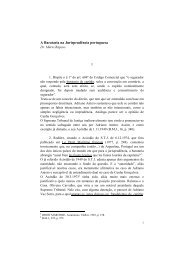

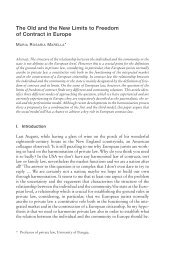

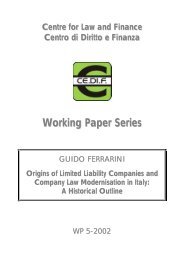
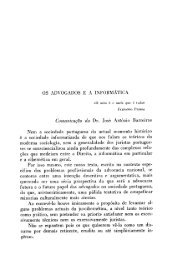
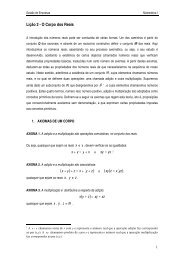

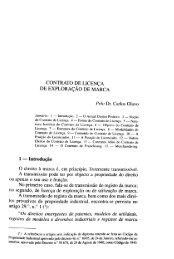
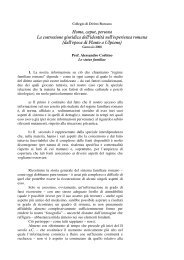
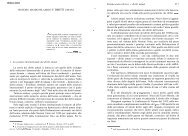

![Luigi Sapio Nozione di islām La parola “islām” [ ] è il mas.dar1 ...](https://img.yumpu.com/15836073/1/185x260/luigi-sapio-nozione-di-islam-la-parola-islam-e-il-masdar1-.jpg?quality=85)
